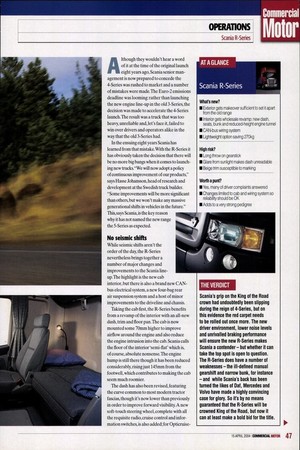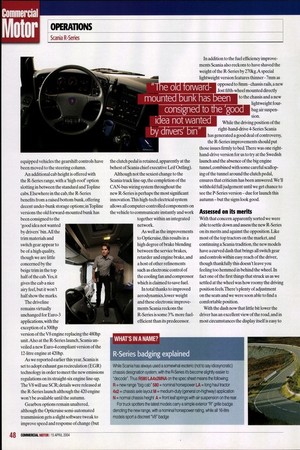LONG LIVE THE KING?
Page 44

Page 45

Page 46

Page 47

If you've noticed an error in this article please click here to report it so we can fix it.
Scania's new R-Series will put the Swedish builder back in favour with drivers, but is it enough for it to be
crowned King of the Road? Andy Salter reports.
A'though they wouldn't hear a word of it at the time of the original launch eight years ago, Scania senior management is now prepared to concede the 4-Series was rushed to market and a number of mistakes were made.The Euro-2 emissions deadline was looming: rather than launching the new engine line-up in the old 3-Series, the decision was made to accelerate the 4-Series launch.The result was a truck that was too heavy, unreliable and, let's face it, failed to win over drivers and operators alike in the way that the old 3-Series had.
In the ensuing eight years Scania has learned from that mistake. With the R-Series it has obviously taken the decision that there will be no more big bangs when it comes to launching new trucks."We will now adopt a policy of continuous improvement of our products," says Hasse Johansson, head of research and development at the Swedish truck builder. "Some improvements will be more significant than others, but we won't make any massive generational shifts in vehicles in the future."
This, says Scania, is the key reason why it has not named the new range the 5-Series as expected. No seismic shifts While seismic shifts aren't the order of the day, the R-Series nevertheless brings together a number of major changes and improvements to the Scania lineup.The highlight is the new cab
new interior, but there is also a brand new CANbus electrical system, a new four-bag rear air suspension system and a host of minor improvements to the driveline and chassis.
Taking the cab first, the R-Series benefits from a revamp of the interior with an all-new dash, trim and floor pan.The cab is now mounted some 70mm higher to improve airflow around the engine and also reduce the engine intrusion into the cab. Scania calls the floor of the interior 'semi-flat' which is, of course, absolute nonsense. The engine hump is still there though it has been reduced considerably, rising just 145mm from the footwell, which contributes to making the cab seem much roomier. The dash has also been revised, featuring the curve common to most modern tractor fascias, though it's now lower than previously in order to improve forward visibility.A new soft-touch steering wheel, complete with all the requisite radio, cruise control and information switches, is also added; for Opticruise
equipped vehicles the gearshift controls have been moved to the steering column. An additional cab height is offered with the R-Series range, with a 'high-roof option slotting in between the standard and Topline cabs. Elsewhere in the cab, the R-Series benefits from a raised bottom bunk, offering decent under-bunk storage options; in Topline versions the old forward-mounted bunk has
been consigned to the 'good idea not wanted by drivers' bin.All the trim materials and switch gear appear to be of a high quality, though we are little concerned by the beige trim in the top half of the cab. Yes, it gives the cab a nice airy feel, but it won't half show the marks. The driveline remains virtually unchanged for Euro-3 applications, with the exception of a 500hp
version of the V8 engine replacing the 480hp unit.Also at the R-Series launch, Scania unveiled a new Euro-4 compliant version of the 12-litre engine at 420hp.
As we reported earlier this year, Scania is set to adopt exhaust gas recirculation (EGR) technology in order to meet the new emissions regulations on its straight-six engine line-up. The V8 will use SCR; details were released at the R-Series launch although the 420 engine won't be available until the autumn. Gearbox options remain unaltered, although the Opticruise semi-automated transmission gets a slight software tweak to improve speed and response of change (but
the clutch pedal is retained, apparently at the behest of Scania chief executive Leif Ostling). Although not the sexiest change to the Scania truck line-up, the completion of the CAN-bus wiring system throughout the new R-Series is perhaps the most significant innovation.This high-tech electrical system allows all computer-controlled components on the vehicle to communicate instantly and work
together within an integrated network.
As well as the improvements to Opticruise, this results in a high degree of brake blending between the service brakes, retarder and engine brake, and a host of other refinements such as electronic control of the cooling fan and compressor which is claimed to save fuel.
In total thanks to improved aerodynamics, lower weight and these electronic improvements Scania reckons the R-Series is some 3% more fuelefficient than its predecessor. In addition to the fuel efficiency improvements Scania also reckons to have shaved the weight of the R-Series by 270kg.A special lightweight version features thinner 7mm as opposed to 8mm chassis rails, a new Jost fifth-wheel mounted directly to the chassis and a new lightweight four
I bag air suspension. While the driving position of the right-hand-drive 4-Series Scalia has generated a good deal of controversy,
the R-Series improvements should put those issues firmly to bed.There was one righthand-drive version for us to try at the Swedish launch and the absence of the big engine tunnel, combined with some careful scalloping of the tunnel around the clutch pedal, ensures that criticism has been answered.We'll withhold full judgement until we get chance to see the P-Series version — due for launch this autumn —but the signs look good. Assessed on its merits
With that concern apparently sorted we were able to settle down and assess the new R-Series on its merits and against the opposition. Like most of the top tractors on the market, and continuing a Scania tradition, the new models have a curved dash that brings all switch gear and controls within easy reach of the driver, though thankfully this doesn't leave you feeling too hemmed in behind the wheel. In fact one of the first things that struck us as we settled at the wheel was how roomy the driving position feels.There's plenty of adjustment on the seats and we were soon able to find a comfortable position. With the dash now that little bit lower the driver has an excellent view of the road, and in most circumstances the display itself is easy to
read. However, when the sun shines directly onto it you can't see what's going on and on a couple of occasions we thought a warning light had come on when in fact it was just the glare of the sun. We hope this will be rectified soon.
With the cab raised by 70mm we'd have forgiven the R-Series a degree of sway through the corners but to the designers' credit the cab remained rock solid — driving the R-Series is an extremely pleasurable experience. One downside of reducing the height of the engine tunnel
is that the gearstick is now very long so big movements are needed during changes.The gearshift could also do with some improvement in throw and feel as the changes were rather notchy. Opticruise, though noticeably faster than previously, trails some way behind alternative systems from ZF and Volvo when it comes to intuitiveness, so while we like the new column-mounted controls it is not our first choice of auto box.
While the manual gearshift, previously one of Scania's best points, has got worse with RSeries, the braking set-up has vastly improved. The disc brakes, engine brake and retarder work together with a press of the centre pedal to give instant reaction and excellent feel with none of the old spongy brake syndrome. In-cab noise levels are now admirably low, helped by Scania's introduction of the HPi fuel system on its engines, and the truck breezes along with little fuss. Scania engines have always demonstrated excellent power and torque characteristics and in the R-Series the two combine to give speedy performance. • R-Series badging explained
While Scania has always used a somewhat esoteric (not to say idiosyncratic) chassis designation system, with the R-Series it's become slightly easier to "decode". Thus R580 LA4x2MNA on the spec sheet means the following: R = new range "big cab" 580 = nominal horsepower LA = long haul tractor 4x2 = chassis axle layout M = medium-duty (general on-highway) application N = normal chassis height A = front leaf springs with air suspension on the rear. For truck spotters the latest models carry a simple exterior "R" grille badge denoting the new range, with a nominal horsepower rating, while all 16-litre models sport a discreet "V8" badge
























































































































































































